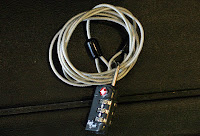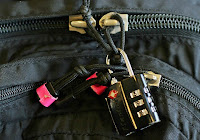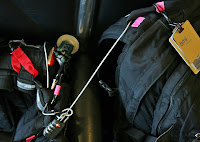Protecting Your Bags In The Airports 101 – Part 1
Web: www.fishfoto.com — E-Mail: fish@flyingwithfish.com
6/05/2008 – Protecting Your Bags In The Airports 101 – Part 1
When traveling through an airport or train station there are simple ways to protect your bags against theft.
The simplest way to secure your bags is a compact combination lock and short cable. These two items, that are between US$7 and US$15 will generally deter a thief before they even put any effort into devising a way to steal from you. A thief must be quick and quiet, and it is very difficult to be quick and quiet when breaking into a locked bag.
When walking through the streets, a train station or an airport, I lock the zippers of my bag. By making sure my zippers are locked, and pulled all the way down to one side it makes it extremely difficult for a thief to get into my bag without me noticing it. On the street, or in a train station, a skilled thief can use a sharp knife to slice into a bag, which is why it’s always best to use a bag of a thicker material, such as ballistic nylon. When looking for a bag, I like to find bags that have some additional internal padding on the bottom that would make a quick “slice and dice” more challenging. Inside an airport a knife is much less likely, but a lock keeping your zippers shut keeps fast hands out of your possessions.
When I spend any time in a single spot for more than five minutes while in a train station, an airport, or even when riding on a train, I use a lock and cable combination to keep hands out of my bag and to keep my bag exactly where I left it. Most bags look alike and can be easy to walk away with. I often travel with a backpack and either a waist pack or belt system. Both can be very easy to snatch, so to prevent this I use a short cable from Eagle Creek with a three-dial combination lock.
To secure my bag I run the short cable through two points in the backpack, generally the top handle and another secure point in the backpack. For the waist pack or belt system I loop the cable through two secure points in that system, then wrap my cable around a metal post in a bench, along the floor or through an arm rest or seat back two or three times. The looping of the cable through a bag more than once makes it tighter and harder to pull away at first tug. If there is no easy ‘snatch’ most thieves will move onto the next target. A thief can’t stand next to a bag’s owner and struggle trying to walk off with a bag.
You can find the cable and lock set at www.eaglecreek.com , or at REI, EMS or other travel shops. A combination travel lock can be found nearly anywhere and are made by a variety of companies.
Below are a few photos of my bags and how I secure them. The first photo is of the Eagle Creek lock & cable kit; the second photo is of how I use a single lock to secure four zippers on my North Face Borealis backpack; the third photo is of my Newswear belt system and North Face Borealis backpack secured to a bench at Hartford/Springfield Bradley Int’l Airport.
Happy Flying!





I wanted to throw out a tip for your traveling photog’s. I always take a towel from the Hotel and line the bottom of my pack with it prior to packing my pack for the day. Then I put my items in the towel in the bottom of my pack. That way if you happen to have a bad-guy slash you pack, nothing can fall out do to the towel acting like an extra layer. It works well and gives you a towel to use if you happen to end up needing one during the day.
Great stuff as always fish! I make my own locking cables from thin wire rope and fittings available from any decent hardware store. For less than $10 you can make 3 cables of 3-4 feet each to go with locks you probably already own.
PS: Another Crunchie bar fanatic – I have relatives in the UK bring them when they come!
Rick — why not just take a towel from home rather than steal a towel from the hotel?